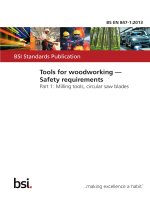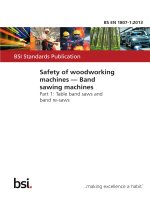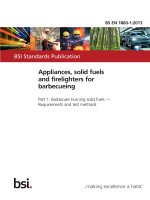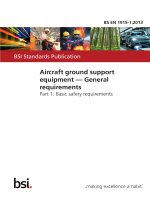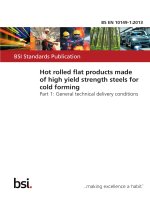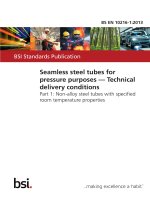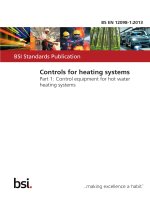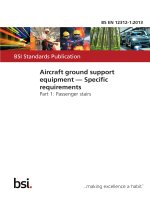Bsi bs en 61496 1 2013 (2015)
Bạn đang xem bản rút gọn của tài liệu. Xem và tải ngay bản đầy đủ của tài liệu tại đây (1.53 MB, 56 trang )
BS EN 61496-1:2013
Incorporating corrigendum April 2015
BSI Standards Publication
Safety of machinery —
Electro-sensitive protective
equipment
Part 1: General requirements and tests
BRITISH STANDARD
BS EN 61496-1:2013
National foreword
This British Standard is the UK implementation of EN 61496-1:2013. It is
identical to IEC 61496-1:2012, incorporating corrigendum April 2015.
It supersedes BS EN 61496-1:2004+A1:2008 which is withdrawn.
The start and finish of text introduced or altered by corrigendum is
indicated in the text by tags. Text altered by IEC corrigendum April 2015
is indicated in the text by ˆ‰ .
The UK participation in its preparation was entrusted to Technical
Committee MCE/3, Safeguarding of machinery.
A list of organizations represented on this committee can be obtained on
request to its secretary.
This publication does not purport to include all the necessary provisions of
a contract. Users are responsible for its correct application.
© The British Standards Institution 2015.
Published by BSI Standards Limited 2015
ISBN 978 0 580 90360 1
ICS 13.110; 29.260.99
Compliance with a British Standard cannot confer immunity from
legal obligations.
This British Standard was published under the authority of the
Standards Policy and Strategy Committee on 31 December 2013.
Amendments/corrigenda issued since publication
Date
Text affected
30 June 2015
Implementation of IEC corrigendum April 2015
EN 61496-1
EUROPEAN STANDARD
NORME EUROPÉENNE
EUROPÄISCHE NORM
November 2013
ICS 13.110; 29.260.99
Supersedes EN 61496-1:2004
English version
Safety of machinery Electro-sensitive protective equipment Part 1: General requirements and tests
(IEC 61496-1:2012)
Sécurité des machines Equipements de protection électrosensibles Partie 1: Prescriptions générales et essais
(CEI 61496-1:2012)
Sicherheit von Maschinen Berührungslos wirkende
Schutzeinrichtungen Teil 1: Allgemeine Anforderungen und
Prüfungen
(IEC 61496-1:2012)
This European Standard was approved by CENELEC on 2012-05-10. CENELEC members are bound to comply
with the CEN/CENELEC Internal Regulations which stipulate the conditions for giving this European Standard
the status of a national standard without any alteration.
Up-to-date lists and bibliographical references concerning such national standards may be obtained on
application to the CEN-CENELEC Management Centre or to any CENELEC member.
This European Standard exists in three official versions (English, French, German). A version in any other
language made by translation under the responsibility of a CENELEC member into its own language and notified
to the CEN-CENELEC Management Centre has the same status as the official versions.
CENELEC members are the national electrotechnical committees of Austria, Belgium, Bulgaria, Croatia, Cyprus,
the Czech Republic, Denmark, Estonia, Finland, Former Yugoslav Republic of Macedonia, France, Germany,
Greece, Hungary, Iceland, Ireland, Italy, Latvia, Lithuania, Luxembourg, Malta, the Netherlands, Norway, Poland,
Portugal, Romania, Slovakia, Slovenia, Spain, Sweden, Switzerland, Turkey and the United Kingdom.
CENELEC
European Committee for Electrotechnical Standardization
Comité Européen de Normalisation Electrotechnique
Europäisches Komitee für Elektrotechnische Normung
CEN-CENELEC Management Centre: Avenue Marnix 17, B - 1000 Brussels
© 2013 CENELEC -
All rights of exploitation in any form and by any means reserved worldwide for CENELEC members.
Ref. No. EN 61496-1:2013 E
BS EN 61496-1:2013
EN 61496-1:2013
-2-
Foreword
The text of document 44/615/CDV, future edition 3 of IEC 61496-1, prepared by IEC/TC 44 "Safety of
machinery - Electrotechnical aspects" was submitted to the IEC-CENELEC parallel vote and approved by
CENELEC as EN 61496-1:2013.
The following dates are fixed:
•
•
latest date by which the document has
to be implemented at national level by
publication of an identical national
standard or by endorsement
latest date by which the national
standards conflicting with the
document have to be withdrawn
(dop)
2014-05-29
(dow)
2015-05-10
This document supersedes EN 61496-1:2004.
EN 61496-1:2013 includes the following significant technical changes with respect to EN 61496-1:2004:
The design, test and verification requirements have been updated to make them consistent with the latest
standards for functional safety and EMC.
Attention is drawn to the possibility that some of the elements of this document may be the subject of
patent rights. CENELEC [and/or CEN] shall not be held responsible for identifying any or all such patent
rights.
This document has been prepared under a mandate given to CENELEC by the European Commission
and the European Free Trade Association, and supports essential requirements of EU Directive(s).
For the relationship with EU Directive(s) see informative Annex ZZ, which is an integral part of this
document.
Endorsement notice
The text of the International Standard IEC 61496-1:2012 was approved by CENELEC as a European
Standard without any modification.
In the official version, for Bibliography, the following notes have to be added for the standards indicated:
IEC 60812
NOTE Harmonized as EN 60812.
IEC 61025
NOTE Harmonized as EN 61025.
BS EN 61496-1:2013
EN 61496-1:2013
-3-
Annex ZA
(normative)
Normative references to international publications
with their corresponding European publications
The following documents, in whole or in part, are normatively referenced in this document and are
indispensable for its application. For dated references, only the edition cited applies. For undated
references, the latest edition of the referenced document (including any amendments) applies.
NOTE When an international publication has been modified by common modifications, indicated by (mod), the relevant EN/HD
applies.
Publication
Year
Title
EN/HD
Year
IEC 60068-2-6
-
Environmental testing Part 2-6: Tests - Test Fc: Vibration
(sinusoidal)
EN 60068-2-6
-
IEC 60068-2-27
-
Environmental testing Part 2-27: Tests - Test Ea and guidance:
Shock
EN 60068-2-27
-
IEC 60204-1 (mod) 2005
+ A1
2008
Safety of machinery - Electrical equipment of EN 60204-1
machines + corr. February
Part 1: General requirements
+ A1
2006
2010
2009
IEC 60445
-
Basic and safety principles for man-machine EN 60445
interface, marking and identification Identification of equipment terminals,
conductor terminations and conductors
-
IEC 60447
-
Basic and safety principles for man-machine EN 60447
interface, marking and identification Actuating principles
-
IEC 60529
-
Degrees of protection provided by enclosures (IP Code)
-
IEC 60947-1
+ A1
2007
2010
Low-voltage switchgear and controlgear Part 1: General rules
2007
2011
IEC 61000-4-2
-
Electromagnetic compatibility (EMC) EN 61000-4-2
Part 4-2: Testing and measurement
techniques - Electrostatic discharge immunity
test
-
IEC 61000-4-3
-
Electromagnetic compatibility (EMC) Part 4-3: Testing and measurement
techniques - Radiated, radio-frequency,
electromagnetic field immunity test
EN 61000-4-3
-
IEC 61000-4-4
2004
Electromagnetic compatibility (EMC) Part 4-4: Testing and measurement
techniques - Electrical fast transient/burst
immunity test
EN 61000-4-4
2004
IEC 61000-4-5
2005
Electromagnetic compatibility (EMC) Part 4-5: Testing and measurement
techniques - Surge immunity test
EN 61000-4-5
2006
IEC 61000-4-6
-
Electromagnetic compatibility (EMC) Part 4-6: Testing and measurement
techniques - Immunity to conducted
disturbances, induced by radio-frequency
fields
EN 61000-4-6
-
IEC 61000-6-2
-
Electromagnetic compatibility (EMC) Part 6-2: Generic standards - Immunity for
industrial environments
EN 61000-6-2
-
EN 60947-1
+ A1
BS EN 61496-1:2013
EN 61496-1:2013
-4-
Publication
IEC 61131-2
Year
2007
Title
Programmable controllers Part 2: Equipment requirements and tests
EN/HD
EN 61131-2
IEC 61508
Series Functional safety of
EN 61508
electrical/electronic/programmable electronic
safety-related systems
Series
IEC/TS 62046
-
Safety of machinery - Application of protective CLC/TS 62046
equipment to detect the presence of persons
-
IEC 62061
-
Safety of machinery - Functional safety of
safety-related electrical, electronic and
programmable electronic control systems
-
ISO 9001
-
Quality management systems - Requirements EN ISO 9001
-
ISO 12100
2010
Safety of machinery - General principles for
design - Risk assessment and risk reduction
EN ISO 12100
2010
ISO 13849-1
-
Safety of machinery - Safety-related parts of
control systems Part 1: General principles for design
EN ISO 13849-1
-
ISO 13849-2
2003
Safety of machinery - Safety-related parts of
control systems Part 2: Validation
EN ISO 13849-2
2008
EN 62061
Year
2007
-5-
BS EN 61496-1:2013
EN 61496-1:2013
Annex ZZ
(informative)
Coverage of Essential Requirements of EU Directives
This European Standard has been prepared under a mandate given to CENELEC by the European
Commission and the European Free Trade Association and within its scope the standard covers only the
following essential requirement out of those given in annex I of the EU Directive 2006/42/EC:
-
1.2.1
1.4.3
Compliance with this standard provides one means of conformity with the specified essential
requirements of the Directive concerned.
WARNING - Other requirements and other EU Directives may be applicable to the products falling within
the scope of this standard.
–6–
BS EN 61496-1:2013
61496-1 © IEC:2012
CONTENTS
INTRODUCTION ..................................................................................................................... 8
1
Scope ............................................................................................................................... 9
2
Normative references ....................................................................................................... 9
3
Terms and definitions .....................................................................................................10
4
Functional, design and environmental requirements ....................................................... 15
4.1
5
Functional requirements ........................................................................................ 15
4.1.1 Normal operation ....................................................................................... 15
4.1.2 Sensing function ........................................................................................ 15
4.1.3 Types of ESPE .......................................................................................... 15
4.1.4 Types and required safety performance ..................................................... 16
4.1.5 Required PL r or SIL and corresponding ESPE type ................................... 16
4.2 Design requirements ............................................................................................. 16
4.2.1 Electrical supply ........................................................................................ 16
4.2.2 Fault detection requirements ..................................................................... 17
4.2.3 Electrical equipment of the ESPE .............................................................. 18
4.2.4 Output signal switching devices (OSSD) .................................................... 19
4.2.5 Indicator lights and displays ...................................................................... 21
4.2.6 Adjustment means ..................................................................................... 22
4.2.7 Disconnection of electrical assemblies ...................................................... 22
4.2.8 Non-electrical components ........................................................................ 22
4.2.9 Common cause failures ............................................................................. 22
4.2.10 Programmable or complex integrated circuits ............................................ 22
4.2.11 Software, programming, functional design of integrated circuits ................. 22
4.3 Environmental requirements .................................................................................. 23
4.3.1 Ambient air temperature range and humidity .............................................. 23
4.3.2 Electrical disturbances............................................................................... 23
4.3.3 Mechanical environment ............................................................................ 25
4.3.4 Enclosures ................................................................................................ 26
Testing ........................................................................................................................... 26
5.1
5.2
5.3
General ................................................................................................................. 26
5.1.1 Type tests ................................................................................................. 26
5.1.2 Test conditions .......................................................................................... 27
5.1.3 Test results ............................................................................................... 28
Functional tests ..................................................................................................... 28
5.2.1 Sensing function ........................................................................................ 28
5.2.2 Response time .......................................................................................... 28
5.2.3 Limited functional tests .............................................................................. 29
5.2.4 Periodic test .............................................................................................. 30
5.2.5 Indicator lights and displays ...................................................................... 30
5.2.6 Means of adjustment ................................................................................. 30
5.2.7 Rating of components ................................................................................ 30
5.2.8 Output signal switching devices (OSSD) .................................................... 30
Performance testing under fault conditions ............................................................ 31
5.3.1 General ..................................................................................................... 31
5.3.2 Type 1 ESPE ............................................................................................. 31
BS EN 61496-1:2013
61496-1 © IEC:2012
–7–
6
5.3.3 Type 2 ESPE ............................................................................................. 31
5.3.4 Type 3 ESPE ............................................................................................. 31
5.3.5 Type 4 ESPE ............................................................................................. 32
5.4 Environmental tests ............................................................................................... 32
5.4.1 Rated supply voltage ................................................................................. 32
5.4.2 Ambient temperature variation and humidity .............................................. 32
5.4.3 Effects of electrical disturbances ............................................................... 33
5.4.4 Mechanical influences ............................................................................... 35
5.4.5 Enclosures ................................................................................................ 35
5.5 Validation of programmable or complex integrated circuits .................................... 35
5.5.1 General ..................................................................................................... 35
5.5.2 Complex or programmable integrated circuits ............................................ 36
5.5.3 Software, programming, functional design of integrated circuits ................. 36
5.5.4 Test results analysis statement .................................................................. 36
Marking for identification and for safe use ...................................................................... 36
7
6.1 General ................................................................................................................. 36
6.2 ESPE supplied from a dedicated power supply ...................................................... 37
6.3 ESPE supplied from an internal electrical power source ........................................ 37
6.4 Adjustment ............................................................................................................ 37
6.5 Enclosures ............................................................................................................ 37
6.6 Control devices ..................................................................................................... 37
6.7 Terminal markings ................................................................................................. 37
6.8 Marking durability .................................................................................................. 38
Accompanying documents .............................................................................................. 38
Annex A (normative)
Optional functions of the ESPE .......................................................... 41
Annex B (normative) Catalogue of single faults affecting the electrical equipment of
the ESPE, to be applied as specified in 5.3 ........................................................................... 48
Annex C (informative) Conformity assessment ..................................................................... 49
Bibliography .......................................................................................................................... 50
Index .................................................................................................................................... 51
Figure 1 – Examples of ESPEs using safety-related communication interfaces ..................... 21
Figure 2 – Test setup for the EMC test of ESPEs with safety-related communication
interfaces .............................................................................................................................. 28
Table 1 – Types and required safety performance ................................................................. 16
Table 2 – Required PL r or SIL and corresponding ESPE type ............................................... 16
Table 4 – Supply voltage interruptions .................................................................................. 23
–8–
BS EN 61496-1:2013
61496-1 © IEC:2012
INTRODUCTION
An electro-sensitive protective equipment (ESPE) is applied to machinery presenting a risk of
personal injury. It provides protection by causing the machine to revert to a safe condition
before a person can be placed in a hazardous situation.
This part of IEC 61496 provides general design and performance requirements of ESPEs for
use over a broad range of applications. Essential features of equipment meeting the
requirements of this standard are the appropriate level of safety-related performance provided
and the built-in periodic functional checks/self-checks that are specified to ensure that this
level of performance is maintained.
Each type of machine presents its own particular hazards and it is not the purpose of this
standard to recommend the manner of application of the ESPE to any particular machine. The
application of the ESPE should be a matter for agreement between the equipment supplier,
the machine user and the enforcing authority, and in this context attention is drawn to the
relevant guidance established internationally, for example ISO 12100.
This part of IEC 61496 specifies technical requirements of electro-sensitive protective
equipment. The application of this standard may require the use of substances and/or test
procedures that could be injurious to health unless adequate precautions are taken.
Conformance with this standard in no way absolves either the supplier or the user from
statutory obligations relating to the safety and health of persons during the use of the
equipment covered by this standard.
Due to the complexity of the technology used to implement ESPEs, there are many issues
that are highly dependent on analysis and expertise in specific test and measurement
techniques. In order to provide a high level of confidence, independent review by relevant
experts is recommended.
BS EN 61496-1:2013
61496-1 © IEC:2012
–9–
SAFETY OF MACHINERY –
ELECTRO-SENSITIVE PROTECTIVE EQUIPMENT –
Part 1: General requirements and tests
1
Scope
This part of IEC 61496 specifies general requirements for the design, construction and testing
of non-contact electro-sensitive protective equipment (ESPE) designed specifically to detect
persons as part of a safety related system. Special attention is directed to functional and
design requirements that ensure an appropriate safety-related performance is achieved. An
ESPE may include optional safety-related functions, the requirements for which are given in
Annex A.
The particular requirements for specific types of sensing function are given in other parts of
this standard.
This standard does not specify the dimensions or configuration of the detection zone and its
disposition in relation to hazards in any particular application, nor what constitutes a
hazardous state of any machine. It is restricted to the functioning of the ESPE and how it
interfaces with the machine.
While a data interface can be used to control optional safety-related ESPE functions
(Annex A), this standard does not provide specific requirements. Requirements for these
safety-related functions can be determined by consulting other standards (for example,
IEC 61508, IEC/TS 62046, IEC 62061, and ISO13849-1).
This standard may be relevant to applications other than those for the protection of persons,
for example for the protection of machinery or products from mechanical damage. In those
applications, different requirements can be necessary, for example when the materials that
have to be recognized by the sensing function have different properties from those of
persons.
This standard does not deal with electromagnetic compatibility (EMC) emission requirements.
2
Normative references
The following documents, in whole or in part, are normatively referenced in this document and
are indispensable for its application. For dated references, only the edition cited applies. For
undated references, the latest edition of the referenced document (including any
amendments) applies.
IEC 60068-2-6, Environmental testing – Part 2-6: Tests – Test Fc: Vibration (sinusoidal)
IEC 60068-2-27, Environmental testing – Part 2-27: Tests – Test Ea and guidance: Shock
IEC 60204-1:2009, Safety of machinery – Electrical equipment of machines – Part 1: General
requirements
IEC 60445, Basic and safety principles for man-machine interface, marking and identification
– Identification of equipment terminals, conductor terminations and conductors
IEC 60447, Basic and safety principles for man-machine interface, marking and identification
– Actuating principles
BS EN 61496-1:2013
61496-1 © IEC:2012
– 10 –
IEC 60529, Degrees of protection provided by enclosures (IP code)
IEC 60947-1:2011, Low-voltage switchgear and controlgear – Part 1: General rules
IEC 61000-4-2, Electromagnetic compatibility (EMC) – Part 4-2: Testing and measurement
techniques – Electrostatic discharge immunity test
IEC 61000-4-3, Electromagnetic compatibility (EMC) – Part 4-3: Testing and measurement
techniques – Radiated, radio-frequency, electromagnetic field immunity test
IEC 61000-4-4:2004, Electromagnetic compatibility (EMC) – Part 4: Testing and measurement
techniques – Section 4: Electrical fast transient/burst immunity test
IEC 61000-4-5:2005, Electromagnetic compatibility
measurement techniques – Surge immunity test
(EMC)
–
Part
4-5:
Testing
and
IEC 61000-4-6, Electromagnetic compatibility (EMC) – Part 4-6: Testing and measurement
techniques – Immunity to conducted disturbances, induced by radio-frequency fields
IEC 61000-6-2, Electromagnetic compatibility (EMC)
Immunity for industrial environments
–
Part
6-2:
Generic
standards –
IEC 61131-2:2007, Programmable controllers – Part 2: Equipment requirements and tests
IEC 61508 (all parts), Functional safety of electrical/electronic/programmable electronic
safety-related systems
IEC 62061, Safety of machinery – Functional safety of safety-related electrical, electronic and
programmable electronic control systems
IEC/TS 62046, Safety of machinery – Application of protective equipment to detect the
presence of persons
ISO 9001, Quality management systems – Requirements
ISO 12100:2010, Safety of machinery – General principles for design – Risk assessment and
risk reduction
ISO 13849-1, Safety of machinery – Safety-related parts of control systems – Part 1: General
principles for design
ISO 13849-2:2003, Safety of machinery – Safety-related parts of control systems – Part 2:
Validation
3
Terms and definitions
For the purposes of this document, the following terms and definitions apply.
NOTE The index lists, in alphabetical order, the terms and acronyms defined in Clause 3 and indicates where
they are used in the text of this part.
3.1
blanking
optional function that permits an object of a size greater than the detection capability of the
ESPE to be located within the detection zone without causing an OFF-state of the OSSD(s)
Note 1 to entry: Fixed blanking is a technique wherein the locations of the blanked areas of the detection zone do
not change during operation. The detection capability of the other parts of the detection zone remains unchanged.
Note 2 to entry: Floating blanking is a technique wherein the blanked area of the detection zone follows the
location of a moving object(s) during operation. The detection capability of the other areas remains unchanged.
BS EN 61496-1:2013
61496-1 © IEC:2012
– 11 –
3.2
controlling/monitoring device
part of the electro-sensitive protective equipment (ESPE) that:
–
receives and processes information from the sensing device and provides signals to the
output signal switching devices (OSSD),
–
monitors the sensing device and the OSSD
3.3
detection capability
sensing function parameter limit specified by the supplier that will cause actuation of the
electro-sensitive protective equipment (ESPE)
3.4
detection zone
zone within which a specified test piece will be detected by the electro-sensitive protective
equipment (ESPE)
3.5
electro-sensitive protective equipment
ESPE
assembly of devices and/or components working together for protective tripping or presencesensing purposes and comprising as a minimum
–
a sensing device;
–
controlling/monitoring devices;
–
output signal switching devices and/or a safety-related data interface
Note 1 to the entry: The safety-related control system associated with the ESPE, or the ESPE itself, may further
include a secondary switching device, muting functions, stopping performance monitor, etc. (see Annex A).
Note 2 to entry:
A safety-related communication interface can be integrated in the same enclosure as the ESPE.
3.6
external device monitoring
EDM
means by which the electro-sensitive protective equipment (ESPE) monitors the state of
control devices which are external to the ESPE
3.7
failure
termination of the ability of an item to perform a required function
[SOURCE: IEC 60050-191:1990, 191-04-01, modified]
Note 1 to entry:
After failure the item has a fault.
Note 2 to entry:
'Failure' is an event, as distinguished from 'fault', which is a state.
Note 3 to entry:
This concept, as defined, does not apply to items consisting of software only.
Note 4 to entry:
In practice, the terms fault and failure are often used synonymously.
3.8
failure to danger
failure which prevents or delays all output signal switching devices going to, and/or remaining
in the OFF-state in response to a condition which, in normal operation, would result in their so
doing
– 12 –
BS EN 61496-1:2013
61496-1 © IEC:2012
3.9
fault
state of an item characterized by inability to perform a required function, excluding the
inability during preventive maintenance or other planned actions, or due to lack of external
resources
[SOURCE: IEC 60050-191:1990, 191-05-01]
Note 1 to entry:
A fault is often the result of a failure of the item itself, but may exist without prior failure.
Note 2 to entry: In English the term “fault” and its definition are identical with those given in IEV 191-05-01. In the
field of machinery, the French term “défaut” and the German term “Fehler” are used rather than the terms “panne”
and “Fehlzustand” that appear with this definition.
3.10
final switching device
FSD
component of the machine's safety-related control system that interrupts the circuit to the
machine primary control element (MPCE) when the output signal switching device (OSSD)
goes to the OFF-state
3.11
integrated circuit – complex or programmable
monolithic, hybrid or module circuit which satisfies one or more of the criteria below:
a) more than 1 000 gates are used in the digital mode,
b) more than 24 functionally different external electrical connections are available for use;
c) the functions can be programmed
Note 1 to entry:
Examples include ASICs, ROMs, PROMs, EPROMs, PALs, CPUs, PLAs, and PLDs.
Note 2 to entry:
modes.
The circuits may function in the analogue mode, the digital mode, or a combination of the two
3.12
integrated circuit – simple
monolithic, hybrid or module circuit which satisfies none of the criteria in 3.11
Note 1 to entry:
Examples are SSI or MSI logic ICs, comparators.
Note 2 to entry:
two modes.
The circuits may function in the analogue mode, in the digital mode, or in a combination of the
3.13
lock-out condition
condition, initiated by a fault, preventing normal operation of the electro-sensitive protective
equipment (ESPE). All output signal switching devices (OSSDs) and, where applicable, all
secondary switching devices (SSDs) are signalled to go to the OFF-state
3.14
machine primary control element
MPCE
electrically powered element that directly controls the normal operation of a machine in such a
way that it is the last element (in time) to function when machine operation is to be initiated or
arrested
Note 1 to entry: This element can be, for example, a mains contactor, a magnetic clutch or an electrically
operated hydraulic valve.
BS EN 61496-1:2013
61496-1 © IEC:2012
– 13 –
3.15
machine secondary control element
MSCE
machine control element, independent of the machine primary control element(s), that is
capable of removing the source of power from the prime mover of the relevant hazardous
parts
Note 1 to entry:
When fitted, the MSCE is normally controlled by the secondary switching device (SSD).
Note 2 to entry: This element can be, for example, a mains contactor, a magnetic clutch or an electrically
operated hydraulic valve.
3.16
muting
a temporary automatic suspension of a safety function(s) by safety-related parts of the control
system
Note 1 to entry: For ESPE-muting see Clause A.7
3.17
OFF-state
state of the output(s) of the ESPE in which the machine under control is caused to stop
running and is prevented from starting (for example, the output circuit is interrupted and
disables the flow of current)
3.18
ON-state
state of the output(s) of the ESPE in which the machine under control is allowed to run
(for example, the output circuit is complete and enables the flow of current)
3.19
output signal switching device
OSSD
component of the electro-sensitive protective equipment (ESPE) connected to the machine
control system which, when the sensing device is actuated during normal operation, responds
by going to the OFF-state
3.20
overall system stopping performance
time interval resulting from the sum of the electro-sensitive protective equipment (ESPE)
response time and the time to the cessation of hazardous machine operation
3.21
response time
maximum time between the occurrence of the event leading to the actuation of the sensing
device and the output signal switching devices (OSSD) achieving the OFF-state
Note 1 to entry: When an ESPE includes a safety-related data interface, the response time is defined at the
output of the safety-related data interface.
Note 2 to entry: When a safety-related communication interface is included in the ESPE enclosure, then the
response time is defined at the output of the safety-related communication interface. In this case, the response
time is also dependent on the protocol and architecture of the communication network.
Note 3 to entry: If an ESPE has both a safety-related data interface and OSSDs, the ESPE can have a different
response time for the safety-related data interface and for the OSSDs.
– 14 –
BS EN 61496-1:2013
61496-1 © IEC:2012
3.22
restart interlock
means of preventing automatic restarting of a machine after actuation of the sensing device
during a hazardous part of the machine operating cycle, after a change in mode of operation
of the machine, and after a change in the means of start control of the machine
Note 1 to entry: Modes of operation include inch, single stroke, automatic. Means of start control include foot
switch, two-hand control, and single or double actuation of the electro-sensitive protection equipment (ESPE)
sensing device.
3.23
safety-related part of a control system
part or subpart(s) of a control system which respond(s) to input signals and generate(s)
safety-related output signals
Note 1 to entry:
This also includes monitoring systems.
Note 2 to entry: The combined safety-related parts of a control system start at the points where the safety-related
signals are initiated and end at the output of the power control elements (see also ISO 12100, Annex A)
3.24
secondary switching device
SSD
device which, in a lock-out condition goes to the OFF-state. It may be used to initiate an
appropriate machine control action, for example de-energizing the machine secondary control
element (MSCE)
3.25
sensing device
part of the electro-sensitive protective equipment (ESPE) which uses electro-sensitive means
to determine the event or state that the ESPE is intended to detect
EXAMPLE An opto-electronic sensing device would detect an opaque object entering the
detection zone.
3.26
start interlock
means which prevents an automatic machine start when the electrical supply to the electrosensitive protection equipment (ESPE) is switched on, or is interrupted and restored
3.27
stopping performance monitor
SPM
monitoring means to determine whether or not the overall system stopping performance is
within the pre-set limit(s)
3.28
supplier
entity (for example manufacturer, contractor, installer, integrator) that provides equipment or
services associated with the machine
Note 1 to entry:
The user may act in the capacity of a supplier to himself.
3.29
safety-related data interface
direct connection (peer-to-peer) interface between the output of the ESPE and the safetyrelated communication interface that is used to represent the status of the OSSD(s)
NOTE 1 to entry:
A data interface will not have addressing capability.
NOTE 2 to entry:
The safety-related data interface can be bi-directional.
BS EN 61496-1:2013
61496-1 © IEC:2012
– 15 –
3.30
safety-related communication interface
safety-related connection to a standardized communication network intended for safetyrelated control functions
4
Functional, design and environmental requirements
4.1
4.1.1
Functional requirements
Normal operation
Normal operation is the state of an ESPE where no faults are detected and where the
OSSD(s) are allowed to be in the ON-state or the OFF-state depending on the state of the
sensing function and operating mode.
In normal operation, the ESPE shall respond by giving (an) appropriate output signal(s) when
part of a person greater than or equal to the detection capability (as specified in the relevant
part of IEC 61496) enters or is in the detection zone.
The ESPE response time shall not exceed that stated by the supplier. No means of
adjustment of the response time shall be possible without the use of a key, key-word or tool.
4.1.2
Sensing function
The detection capability shall be effective over the detection zone specified by the supplier.
No adjustment of the detection zone, detection capability or blanking function (monitored,
unmonitored, fixed or floating) shall be possible without the use of a key, key-word or tool.
4.1.3
Types of ESPE
In this standard, three types of ESPEs are considered. The types differ in their performance in
the presence of faults and under influences from environmental conditions. In this part, the
effects of electrical and electromechanical faults are considered (such faults are listed in
Annex B). Additional requirements are provided in the other parts where faults generated by
the particular sensing technology employed are considered. It is the responsibility of the
machine manufacturer and/or the user to prescribe which type is required for a particular
application.
NOTE
Requirements for a type 1 ESPE are not being considered at this time.
A type 2 ESPE shall fulfil the fault detection requirements of 4.2.2.3.
For a type 2 ESPE, in normal operation the output circuit of at least one output signal
switching device shall go to the OFF-state when the sensing function is actuated, or when
power is removed from the ESPE.
A type 2 ESPE shall have a means of periodic test.
A type 3 ESPE shall fulfil the fault detection requirements of 4.2.2.4.
A type 4 ESPE shall fulfil the fault detection requirements of 4.2.2.5.
For a type 3 ESPE and for a type 4 ESPE, in normal operation the output circuit of at least
two output signal switching devices shall go to the OFF-state when the sensing function is
actuated, or when power is removed from the ESPE.
When a single safety-related data interface is used to perform the functions of the OSSD(s),
then the data interface and associated safety-related communication interface shall meet the
BS EN 61496-1:2013
61496-1 © IEC:2012
– 16 –
requirements of 4.2.4.4. In this case, a single safety-related data interface can substitute for
two OSSDs in a type 3 or type 4 ESPE.
4.1.4
Types and required safety performance
An ESPE shall meet a level of safety performance in accordance with IEC 62061 and/or ISO
13849-1, as stated in Table 1.
Table 1 – Types and required safety performance
Type
1
Safety performance according to IEC 62061 and/or
ISO 13849-1
N/A
2
3
4
SIL 1 and
SILCL 1
and/or
PL c
SIL 2 and
SILCL 2
and/or
PL d
SIL 3 and
SILCL 3
and/or
PL e
NOTE The device dependent PFH d values claimed for the control electronics is not restricted (for example, a
manufacturer can claim a Type 2 has a PFH d lower than 10 -6 ).
4.1.5
Required PL r or SIL and corresponding ESPE type
In addition to the different levels of safety performance of the electrical parts of an ESPE
control system, the potential risk reduction that can be provided by an ESPE is limited also by
the systematic capabilities (for example, environmental influences, EMC, optical performance
and detection principle). The limits are shown in Table 2.
Table 2 – Required PL r or SIL and corresponding ESPE type
Type
For a safety function that includes an ESPE, the
maximum PL or SIL that can be achieved by the
ESPE
1
2
3
4
N/A
SIL 1
and/or
PL r c
SIL 2 and/or
PL r d
SIL 3 and/or
PL r e
NOTE 1 The intention of Table 2 is to limit the minimum type that should be employed for the risk reduction of a
required safety function. For example: If a safety function requires SIL 2, then from Table 2, it can be seen that a
Type 2 would not be sufficient.
NOTE 2
4.2
Table 2 and related text will be included in the next edition of IEC 62046.
Design requirements
4.2.1
Electrical supply
The ESPE shall be designed to operate correctly with the conditions of the nominal supply as
specified below, unless otherwise specified by the user:
AC supplies
Voltage:
0,85 to 1,1 of nominal voltage
Frequency:
0,99 to 1,01 of nominal frequency (continuously)
0,98 to 1,02 of nominal frequency (short-time)
Harmonics:
Harmonic distortion not to exceed 10 % of the total r.m.s. voltage
nd
th
between live conductors for the sum of the 2 through to the 5
harmonic. An additional 2 % of the total r.m.s. voltage between live
th
th
conductors for the sum of the 6 through to the 30 harmonic is
permissible.
BS EN 61496-1:2013
61496-1 © IEC:2012
– 17 –
DC supplies
From batteries
Voltage:
0,85 to 1,15 of nominal voltage
0,7 to 1,2 of nominal voltage in the case of battery-operated vehicles
From converting equipment
Voltage:
0,9 to 1,1 of nominal voltage
Ripple (peak-to-peak): Shall not exceed 0,05 of nominal voltage.
For protection against electric shock, see 4.2.3.2.
NOTE For protection against electrical interference, the power source should meet the requirements of
IEC 61000-6-2.
4.2.2
Fault detection requirements
4.2.2.1
General
The ESPE shall respond to the faults listed in Annex B, in accordance with 4.2.2.3 to 4.2.2.5
as appropriate. The faults listed in Annex B are not exclusive and, if necessary, additional
faults shall be considered. For new components not mentioned in Annex B, a failure mode
and effects analysis (FMEA, see IEC 60812) shall be carried out to establish the faults that
are to be considered for those components.
From a lock-out condition, it shall not be possible for the ESPE to resume normal operation
(for example, by interruption and restoration of the mains power supply or by reset) while the
fault which initiated the lock-out condition is still present.
At power on and prior to OSSD(s) going to the ON-state, a test shall be performed to verify
the absence of faults within the ESPE.
4.2.2.2
NOTE
Particular requirements for a type 1 ESPE
Particular requirements for a type 1 ESPE are not under consideration at this time.
4.2.2.3
Particular requirements for a type 2 ESPE
A type 2 ESPE shall have a means of periodic test to reveal a failure to danger (for example
loss of detection capability, response time exceeding that specified).
The test shall be performed at power-on of the ESPE before going to the ON-state and at
each reset as a minimum.
NOTE 1 Depending on the application, the periodic test may need to be performed more often to achieve a
desired safety performance.
A single fault resulting in the loss of detection capability or the increase in response time
beyond the specified time or preventing one or more of the OSSDs going to the OFF-state,
shall result in a lock-out condition as a result of the next periodic test.
Where the periodic test is intended to be initiated by an external (for example machine)
safety-related control system, the ESPE shall be provided with suitable input facilities (for
example terminals).
– 18 –
BS EN 61496-1:2013
61496-1 © IEC:2012
The duration of the periodic test shall be such that the intended safety function is not
impaired.
NOTE 2 If the type 2 ESPE is intended for use as a trip device (for example when used as a perimeter guard),
and the duration of the periodic test is greater than 150 ms, it is possible for a person to pass through the detection
zone without being detected. In this case a restart interlock should be included.
If the periodic test is automatically initiated, the correct functioning of the periodic test shall
be monitored. In the event of a fault, the OSSD(s) shall be signalled to go to the OFF-state. If
one or more OSSDs does not go to the OFF-state, a lock-out condition shall be initiated.
An ESPE with only one OSSD shall have a minimum of one SSD (see Clause A.4).
4.2.2.4
Particular requirements for a type 3 ESPE
A single fault resulting in a loss of detection capability or an increase in response time beyond
the specified value or a single fault preventing one or more OSSD going to the OFF-state
shall cause the ESPE to go to a lock-out condition within a time specified in the relevant part
of this standard, or immediately upon any of the following demand events where fault
detection requires a change in state:
–
on actuation of the sensing function;
–
on reset of the start or restart interlock, if available (see Clauses A.5 and A.6).
In cases where a single fault which in itself does not cause a failure to danger is not detected,
the occurrence of one additional fault shall not cause a failure to danger. For verification of
this requirement, see 5.3.4.
4.2.2.5
Particular requirements for a type 4 ESPE
A single fault resulting in a loss of detection capability shall cause the ESPE to go to a lockout condition within the response time.
A single fault resulting in an increase in response time beyond the specified value or a single
fault preventing one or more than one OSSD going to the OFF-state, shall cause the ESPE to
go to a lock-out condition immediately, i.e. within the response time, or immediately upon any
of the following demand events where fault detection requires a change of state:
–
on actuation of the sensing function;
–
on reset of the start or restart interlock, if available (see Clauses A.5 and A.6).
In cases where a single fault which in itself does not cause a failure to danger is not detected,
the occurrence of further faults shall not cause a failure to danger. For verification of this
requirement, see 5.3.5.
NOTE 1
Design measures for a type 4 ESPE may include:
–
single-channel technique with dynamic fault detection measures; or
–
single-channel technique with an internally generated automatic check, performed frequently so that the
automatic check interval for fault detection is included in the safety device response time; and
–
multiple channel techniques such that any disparity between channels results in a lock-out condition.
NOTE 2
4.2.3
4.2.3.1
For additional requirements for integrated circuits, complex or programmable, see 4.2.10.
Electrical equipment of the ESPE
General
The electrical equipment (components) of the ESPE shall:
–
conform to appropriate IEC standards where they exist;
BS EN 61496-1:2013
61496-1 © IEC:2012
– 19 –
–
be suitable for the intended use; and
–
be operated within their specified ratings.
4.2.3.2
Protection against electric shock
Protection against electric shock shall be provided in accordance with 6.1 of IEC 602041:2009.
4.2.3.3
Protection of electrical equipment
Overcurrent protection shall be provided in accordance with 7.2.1, 7.2.3, 7.2.7, 7.2.8, and
7.2.9 of IEC 60204-1:2009.
NOTE Information may need to be given to the user of the ESPE as to the maximum rating of fuses, or setting of
an overcurrent protective device for the circuit(s) connected to the OSSD(s) output connection points.
4.2.3.4
Pollution degree
The electrical equipment shall be suitable for pollution degree 2 (see 6.1.3.2 of IEC 609471:2011).
4.2.3.5
Clearance, creepage distances and isolating distances
The electrical equipment shall be designed and constructed in accordance with 7.1.4 of
IEC 60947-1:2011.
4.2.3.6
Wiring
The electrical equipment shall be wired in accordance with IEC 60204-1:2009.
4.2.4
4.2.4.1
Output signal switching devices (OSSD)
General
Separate output connection points (terminals) shall be provided for each OSSD.
The OSSD should be so rated that their loads can be switched without the use of arc
suppression devices.
NOTE In the interest of improved reliability, it is strongly recommended that switching voltage-suppression
devices are fitted, which should be connected across the loads and not across the contacts.
The output circuit of the OSSDs should be adequately protected to prevent failure to danger,
for example welded contacts under overcurrent conditions (see 7.2.9 of IEC 60204-1:2009).
Measures should be provided to minimize the possibility of failure to danger from common
cause failures.
Some functions of the machine safety-related control system may be performed by the ESPE,
for example the OSSD may perform the function of a FSD.
Both a type 3 ESPE and a type 4 ESPE shall incorporate a minimum of two independently
operated OSSDs.
A reference to an OSSD action (for example, go to the OFF-state) will also mean a
corresponding action of a safety-related data interface. A single safety-related data interface
can meet the requirements of having two OSSDs.
BS EN 61496-1:2013
61496-1 © IEC:2012
– 20 –
4.2.4.2
Relay OSSDs
If relay OSSDs are provided, the state (i.e. position) of the contacts shall be monitored. This
can be achieved by monitoring the state of an auxiliary contact(s) on relays with mechanically
linked (positively guided) contacts. The mechanical link ensures that the monitored contact
follows the change of state of the OSSD contact(s).
Special design and constructional measures shall be used to ensure that the make (normallyopen) contact(s) and the break (normally-closed) contact(s) cannot be in the closed position
simultaneously.
NOTE 1 The mechanical link ensures that the monitored contact follows the change of state of the OSSD
contact(s).
NOTE 2 It is important that relay drop out voltage and the separation distance between the contacts are
maintained at a proper level over the entire stated life of the relay.
4.2.4.3
Solid state OSSDs
Solid state OSSD outputs may be either current sourcing or current sinking types. When
current sourcing outputs are provided, they shall meet the requirements of this Subclause.
NOTE 1 Requirements for current sinking outputs which may be required for certain applications are not defined
in this standard. Special care should be exercised in their use (when current sinking outputs are used, a shortcircuit to the reference potential or an open circuit will be interpreted by the inputs and loads as the ON-state). The
requirements of IEC 60204-1:2009, 9.4.3.1, should also be considered.
NOTE 2 For a nominal rated supply voltage of 24 V d.c., the output voltage and current values for the ON-state
and the OFF-state should be in accordance with the following data:
Nominal supply
voltage
Output range
OFF-state
Output range
ON-state
Output OFF-state
(max. leakage current)
Output ON-state
24 V d.c.
-3 V ... +2 V r.m.s.
(+5 V peak)
+11 V ... +30 V
< 2 mA
> 6 mA
NOTE 3 The values above meet the requirements of IEC 61131-2:2007 (see 3.3 of IEC 61131-2:2007), for a nominal
rated supply voltage of 24 V d.c. When other supply voltages are used, this standard may be used as a guide.
IEC 61131-2:2007 may be referred to for additional information.
The output(s) shall be protected against the effects of overvoltage, overcurrent and short
circuit.
The maximum leakage current shall not exceed 2 mA.
NOTE 4
ˆIt is possible that a leakage current greater than 2 mA can lead to a failure to danger.‰
When there is more than one OSSD, short circuits between the outputs of the OSSDs shall be
detected.
The supplier of the ESPE shall provide the following information in the accompanying
documents:
–
nominal and maximum output current in the ON-state for resistive and inductive loads;
–
maximum OFF-state voltage;
–
maximum output current in OFF-state (leakage current);
–
maximum capacitive load;
–
maximum resistance of the connection(s) between the OSSD(s) and the load(s).
4.2.4.4
Safety-related data interface and safety-related communication interface
When the sensing device is actuated during normal operation, the ESPE shall respond by
sending information indicating the status of the sensing device or ESPE through a safety-
BS EN 61496-1:2013
61496-1 © IEC:2012
– 21 –
related data interface. The status information is converted to a data telegram by a safetyrelated communication interface.
The safety-related data interface shall have the same protection against faults as is
appropriate for the type of ESPE.
Depending on the ESPE design, the safety-related communication interface can either be
external in a separate enclosure (Figure 1a) or it can be integrated in the same enclosure of
the ESPE (Figure 1b).
When the safety-related communication interface is integrated in the ESPE, the entire ESPE
shall meet the relevant requirements of IEC 62061/IEC 61508.
NOTE Because of the specific technology of communication interfaces, different standards from IEC 61496-1
apply. To avoid overlapping with other standards, functional requirements for the safety-related communication
interface are not defined in this standard.
Sensing device
Sensing device
Control/monitoring
device
Control/monitoring
device
Safety-related data
interface
Safety-related data
interface
ESPE
Safety-related
communication
interface
Safety-related
communication interface
a)
b)
IEC 1798/07
Figure 1 – Examples of ESPEs using safety-related communication interfaces
4.2.5
Indicator lights and displays
Devices shall be provided by the ESPE manufacturer to:
a) indicate the actuation of the sensing device. Neither the time from the actuation of the
sensing device to the indicator achieving 50 % of its final brightness (luminescence), nor
the time from the de-actuation of the sensing device to the indicator brightness decaying
to 50 % of its initial brightness, shall exceed 100 ms;
b) indicate the output status of an OSSD. The ON-state shall be represented by a green
indicator, the OFF-state by a red indicator. When two or more OSSDs are intended to
operate in co-ordination, a single set of indicators may be shared.
When there are two or more indicators of the same colour, the function of each indicator shall
be unambiguously marked.
NOTE For some modes of operation, the same set of indicators for a) can also be used for b). A bi-colour
indicator could be used.
– 22 –
BS EN 61496-1:2013
61496-1 © IEC:2012
The indicators are intended for the machine operator. Therefore they shall be capable of
being located near the detection zone and visible when the equipment is installed. They can
be integrated in the sensor elements or as an external equipment installed near by the
detection zone.
4.2.6
Adjustment means
All adjustment means shall be so designed that a failure to danger is not possible at any point
in the range of adjustment. A failure in the adjustment means shall not cause an unintended
change to the configuration of the ESPE.
4.2.7
Disconnection of electrical assemblies
When means are provided to permit disconnection of any subsystem, part of a subsystem or
any plug-in component, such disconnection shall result in at least one OSSD going to the
OFF-state, in accordance with 4.2.2. This requirement includes disconnections both within a
single enclosure and/or between separate enclosures (for example a master/slave sensor
configuration).
4.2.8
Non-electrical components
Non-electrical components shall be suitable for the intended use.
4.2.9
Common cause failures
The design should be such as to minimize the possibility of a failure to danger from common
cause failures arising from:
–
environmental influences;
–
multichannel systems using a common substrate;
–
short circuits between channels of multichannel systems.
NOTE 1 Common cause failures can also result from the use of components degraded by mishandling, faulty
manufacture, etc.
NOTE 2
Common cause failures are treated as a single failure.
None of the components in a common semi-conductor substrate shall be used for more than
one channel of a multi-channel system.
4.2.10
Programmable or complex integrated circuits
Where programmable or complex integrated circuits are used in a type 4 ESPE, the safetyrelated performance shall be maintained by at least two independent controlling/monitoring
channels. This requirement shall be verified in accordance with 5.5.
4.2.11
4.2.11.1
Software, programming, functional design of integrated circuits
General
Where an ESPE implements its safety-related performance by any of the following means, the
additional requirements of 4.2.11.2 shall apply:
a) a software program(s) executed during operation;
b) a programmed device(s), the functions of which were set by a process subsequent to its
original manufacture, for example PAL, PLA, PLD, PROM;
c) a device(s) manufactured to a specific user functional specification, for example ASIC,
mask programmed microprocessor, ROM.
Conformance to these requirements shall be validated in accordance with 5.5.
BS EN 61496-1:2013
61496-1 © IEC:2012
4.2.11.2
– 23 –
Requirements
The software, device program and the device functional design shall be developed in
accordance with IEC 61508-3 for the appropriate SIL or in accordance with ISO 13849-1 for
the appropriate PL.
4.3
Environmental requirements
4.3.1
Ambient air temperature range and humidity
The ESPE shall comply with the requirements of this standard when subjected to ambient
temperature variations from 0 °C to 50 °C. Where it is intended for use outside this range, the
supplier shall specify the temperature range over which the system will continue normal
operation. Compliance with this requirement shall be verified by the tests specified in 5.4.2 at
a non-condensing humidity of 95 % for temperatures between 20 °C and the highest ambient
temperature according to 5.4.2.
4.3.2
Electrical disturbances
4.3.2.1
Supply voltage variations
The ESPE shall not fail to danger when the external supply voltage is reduced steadily and
continuously from the nominal voltage to zero voltage, over a period of 10 s to 20 s, and then
increased in a similar manner from zero voltage to the nominal voltage.
The ESPE shall not fail to danger when each internally derived supply voltage, in turn, is
varied steadily and continuously over a period of 10 s to 20 s, from nominal voltage to zero
voltage, and then increased in a similar manner from zero voltage to nominal voltage.
4.3.2.2
External supply voltage interruptions and dips
When supply voltage interruptions (dips) are applied as in Table 4:
Table 4 – Supply voltage interruptions
Test number
Dip value of rated voltage
Dip time
Dip repetition rate
%
ms
Hz
1)
100
10
10
2)
50
20
5
3)
50
500
0,2
the ESPE shall respond to test 1) and to test 2) by continuing in normal operation, and to
test 3) by not failing to danger.
When the ESPE is designed to be supplied from a specific type of power supply(s) (for
example, supplied direct from a safety-related communication interface), the supply
interruptions in this clause may be applied to the primary input of the specified power supply
instead of direct to the ESPE.
